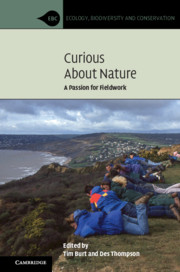Book contents
- Curious About Nature
- Ecology, Biodiversity and Conservation
- Curious About Nature
- Copyright page
- Dedication
- Contents
- Preface
- Foreword
- Part I Getting Curious About Nature
- 1 Fieldwork and Nature: Observing, Experimenting and Thinking
- 2 The Place of Field Studies in Environmental Science
- 3 The History of Fieldwork in the Geosciences
- 4 Pioneering Fieldwork Heroes in the Life Sciences
- 5 The Educational Benefits of Out-of-Classroom Learning
- Part II Essays: Inspiring Fieldwork
- Part III Reflections and Where Next for Field Studies
- Contributing Author Biographies
- Index
- References
4 - Pioneering Fieldwork Heroes in the Life Sciences
from Part I - Getting Curious About Nature
Published online by Cambridge University Press: 11 February 2020
- Curious About Nature
- Ecology, Biodiversity and Conservation
- Curious About Nature
- Copyright page
- Dedication
- Contents
- Preface
- Foreword
- Part I Getting Curious About Nature
- 1 Fieldwork and Nature: Observing, Experimenting and Thinking
- 2 The Place of Field Studies in Environmental Science
- 3 The History of Fieldwork in the Geosciences
- 4 Pioneering Fieldwork Heroes in the Life Sciences
- 5 The Educational Benefits of Out-of-Classroom Learning
- Part II Essays: Inspiring Fieldwork
- Part III Reflections and Where Next for Field Studies
- Contributing Author Biographies
- Index
- References
Summary
Fieldwork in biology is the study of organisms in their environment. It involves the observation of the organisms themselves, their interactions with each other and with their environment, together with the study of spatial patterns and changes over time. Measurement and experimentation may also be involved.
- Type
- Chapter
- Information
- Curious about NatureA Passion for Fieldwork, pp. 87 - 115Publisher: Cambridge University PressPrint publication year: 2020



